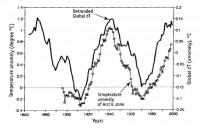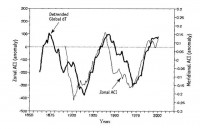By L.B. Klyashtorin, A.A. Lyubushin English Version Edited by Dr. Gary Sharp
Icecap Note: My presentation at the ICCC 2009 conference related to both data integrity and the cycles (averaging around 60 years) of the sun and oceans which fit like a glove with temperatures. I had to leave out the Arctic which exhibits the identical behavior because of time limitations.

Here is a larger graph.
I received a copy of this PDF from the authors of a book that discovered a 60 year cycle and a strong relationship with fish productivity, after they saw the presentation on-line and how well it fit with their book “Climate Changes and Fish Productivity”. Here are some relevant excerpts of their excellent book (PDF here):
Recently, 60-70 year repeating alterations of hemispherical and global climate were detected [Schlesinger, Ramankutty, 1994; Minobe, 1997, 1999, 2000]. Temperature sequences for the recent 1500 years, reconstructed from Greenland ice core samples, show domination of approximately 60-year periodicity of the climate fluctuations [Klyashtorin, Lyubushin, 2003; Klyashtorin, Lyubushin, 2005]. For the same period, similar (50-70 year) temperature periodicity was detected in the analysis of long-living tree annual growth rings in the Arctic region and California. Reconstruction of sardine and anchovy population fluctuations by analysis of scales in bottom sediments in Californian upwelling for the latest 1700 years has indicated their approximately 60-year periodicity [Baumgartner et al., 1992].
At the background of the secular linear trend, Global dT undergoes longperiod, up to 60-year long, fluctuations. These fluctuations can be detected by detrending with the help of a standard statistical operation [Statgraphics, 1988]. After detrending, the long-period fluctuations of Global dT with the maxima at about 1870s, 1930s and, apparently, at 1990s are clearly observed. Global dT detrending allows detection of 2.5 cycles of approximately 60-year global dT fluctuations. An approximately 60-year repeating pattern is also observed well from temperature anomaly dynamics in the circumpolar Arctic zone (Arctic dT) between 60 and 85N. Detrended Global dT behavior compared with Arctic dT is shown in the following:

Here is a larger graph.
The specific feature of the long-period temperature dynamics in the Arctic zone is the absence of secular, linearly increasing temperature trend observed for Global dT (note this is more evidence that the global warming trend is exaggerated, largely due to UHI and data issues as I covered in my ICCC powerpoint). Comparison of detrended Global dT and Arctic dT fluctuation dynamics demonstrates almost complete coincidence in behavior of these two indices during the last 100 years. This indicates that, actually, the Global dT linear increasing trend is not a global phenomenon. At the same time, approximate 60-70-year repeating pattern is observed for both Global dT and Arctic dT [Alekseev et al., 2000; Alekseev, 2003].
Another important climate index is Atmospheric Circulation Index (ACI), which characterizes periods of relative predominance of “zonal” or “meridional” air transfer by the hemisphere. This index is known as the Vangenheim-Girs Index and is calculated from the observations for direction of the air transfer in Atlantic-Eurasian region (30-80N and 45-75E) during the last 110 years [Vangenheim, 1940; Girs, 1971]. The Vangenheim-Girs classification is based on the multiyear repetition of air transfer directions, which is widely used in the works by Russian experts in meteorology and climatology.

Here is a larger graph.
For separating climatic epochs by alteration of atmospheric circulation forms and Global dT fluctuations only upper parts of the curves are used. The scheme clearly demonstrates alteration of warm (zonal) and cold (meridional) epochs with approximately 30-year repetition during the last 110 years. On this basis it is reasonable that the current warm or zonal climatic epoch, started in 1970s, will probably finish in the first decade of 2000s, and the subsequent cold epoch will last since 2010s till 2030s.

Here is a larger graph.
This fits with the prior analysis and also with the work of Easterbrook, Spencer and Tsonis and many others. Read much more of this excellent, thorough review of the conference here in the American Thinker and here in the American Spectator. See videos of the keynotes (and soon of all the talks) and powerpoints of the talks here.




